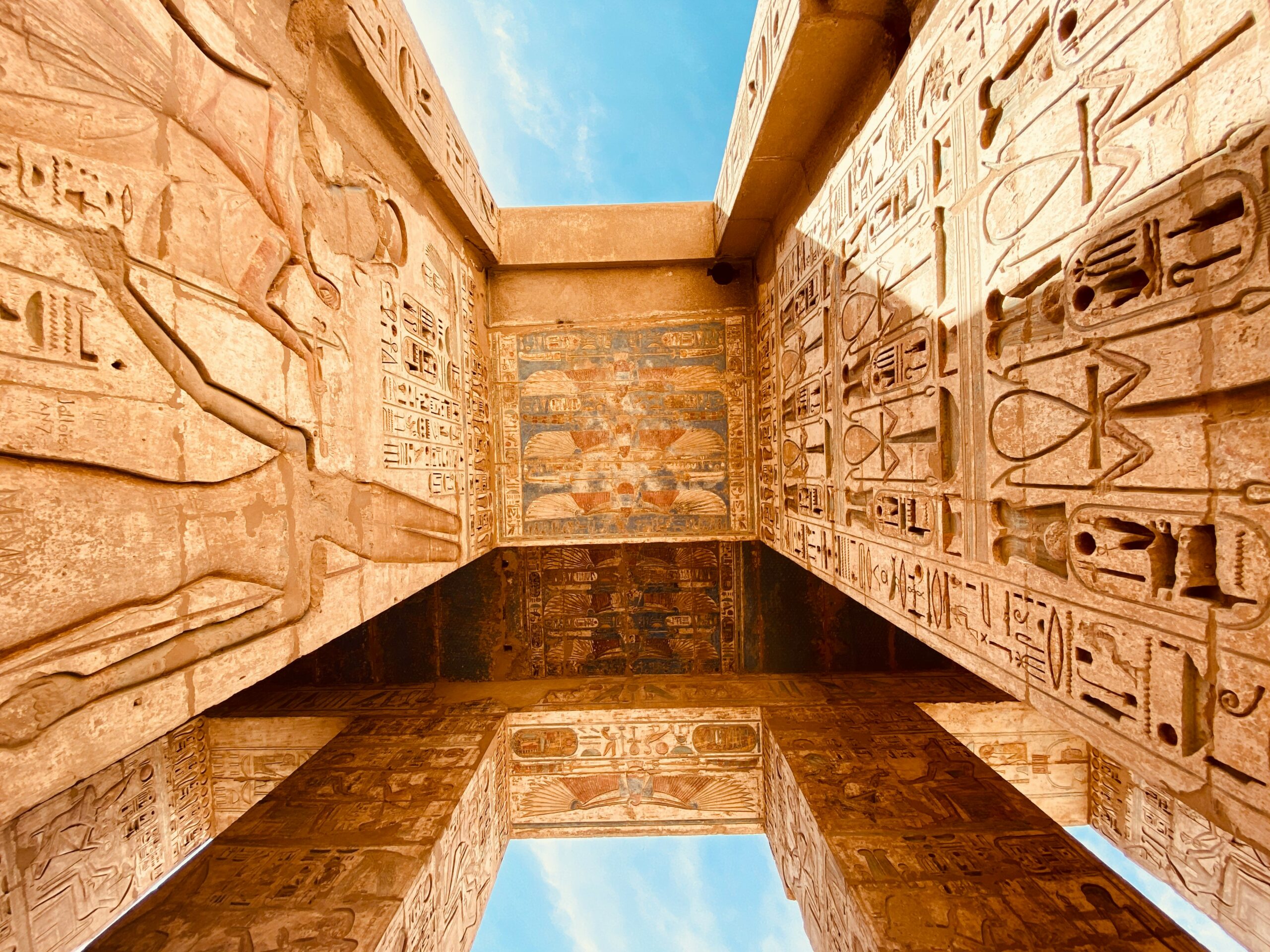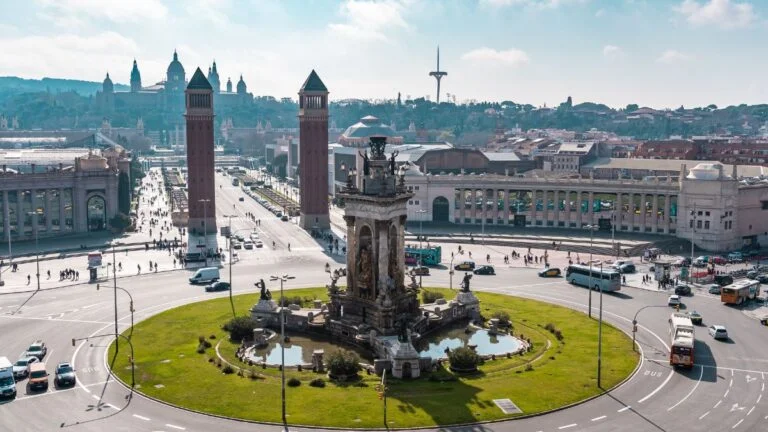50 Facts About Egypt You Need to Know Before Traveling There

As participants in Amazon Associates and other programs, we earn from qualifying purchases. This comes at no additional cost to you. For more details, see our Affiliate Disclosure.
Egypt, a land shrouded in mystery and steeped in history, has beckoned travelers for centuries. From the iconic pyramids that stretch towards the heavens to the winding Nile River that breathes life into an otherwise barren landscape, Egypt is a fusion of ancient marvels and modern dynamics. Whether it’s exploring the vast deserts, marveling at the ancient hieroglyphs, or navigating the bustling streets of Cairo, Egypt offers an adventure that is as enriching as it is exhilarating. Before packing your bags for this timeless land, equip yourself with these 50 essential facts to make your journey not just a trip, but a voyage through the annals of history.
1. The Great Pyramids of Giza are the Only Remaining Wonder of the Ancient World
The Great Pyramids of Giza, standing as timeless sentinels of Egypt’s ancient architectural prowess, are the sole survivors among the Seven Wonders of the Ancient World. Erected as grand tombs for pharaohs Khufu, Khafre, and Menkaure over 4,500 years ago, these monumental structures have fascinated and mystified historians, archaeologists, and travelers alike. Their precise construction, particularly the Great Pyramid’s alignment with the cardinal points and its astonishing mathematical precision, continues to be a subject of study and admiration, embodying the zenith of ancient Egyptian engineering and the enduring legacy of its civilization.
2. The Nile River is the Longest River in the World
The Nile River, a lifeline of Egypt since ancient times, holds the title as the longest river in the world, stretching over 6,650 kilometers (4,130 miles) across eleven countries. It has been the backbone of Egyptian civilization, providing not only a source of irrigation to transform the arid landscape into fertile land but also serving as a crucial means of transport and a source of food. The annual floods of the Nile were so integral to the agricultural cycle that they played a central role in the development of Egyptian society, economy, and culture, making the river an indelible part of Egypt’s identity.
3. Ancient Egyptians Invented the 365-Day Calendar
The ancient Egyptians were pioneers in timekeeping, inventing a solar calendar that remarkably resembles the modern 365-day year. This innovation was driven by the need to predict the annual flooding of the Nile River accurately, a phenomenon upon which their agriculture depended. The Egyptian calendar was divided into 12 months of 30 days each, plus an additional five festal days, aligning closely with the solar year. This system not only facilitated the planning and organization of agricultural activities but also laid the groundwork for future calendar systems.
4. Egypt is Home to One of the World’s Oldest Civilizations
Boasting a history that spans over 5,000 years, Egypt is credited with hosting one of the world’s oldest continuous civilizations. This civilization emerged along the fertile banks of the Nile River, allowing for the development of agriculture, urbanization, and a complex societal structure featuring one of the earliest forms of government. The Egyptians made significant advancements in various fields, including writing, architecture, medicine, and astronomy, profoundly influencing subsequent cultures and leaving a legacy that continues to captivate the world.
5. Hieroglyphs are the Ancient Script of Egypt
Hieroglyphs, the writing system of ancient Egypt, are one of humanity’s earliest forms of written expression, consisting of an intricate system of pictorial symbols. These symbols were used for more than 3,000 years, primarily for monumental inscriptions and religious texts. Hieroglyphs were not only a means of recording language but also held significant artistic and religious importance, embodying the sophistication and depth of Egyptian culture. The decipherment of hieroglyphs in the 19th century, largely thanks to the Rosetta Stone, opened a window into ancient Egyptian civilization, revealing its thoughts, beliefs, and daily life.
6. Egypt’s Sphinx is the Largest Monolithic Statue in the World
The Great Sphinx of Giza, with its lion’s body and human head, is the largest monolithic statue in the world and one of Egypt’s most iconic symbols. Carved directly from a single piece of limestone, the Sphinx stands as a guardian of the Giza Plateau, facing the rising sun and flanking the Giza pyramids. Its origins and purpose are shrouded in mystery, though it is generally believed to represent Pharaoh Khafre, integrating the power of the lion with the authority of the king. The Sphinx continues to be a subject of fascination and study, embodying the mystery and grandeur of ancient Egypt.
7. Cairo is the Largest City in the Arab World
Cairo, the bustling capital of Egypt, holds the distinction of being the largest city in the Arab world and Africa. With a history that dates back to the 10th century, Cairo is a melting pot of cultures, histories, and civilizations. This sprawling metropolis is home to millions and is a vibrant center of commerce, politics, culture, and education. From the narrow alleys of the Khan El-Khalili bazaar to the majestic minarets that dot its skyline, Cairo is a city where the past and present coexist, offering a unique window into the heart of the Middle East.
8. Egypt Houses the Oldest University in the World, Al-Azhar University
Al-Azhar University, founded in Cairo in 970 AD, is recognized as the oldest degree-granting university in the world. Established as a center for Islamic learning, it has maintained a pivotal role in the intellectual and cultural life of the Islamic world throughout its history. Al-Azhar University is not only a revered place of Sunni scholarship but also a significant educational institution that offers a wide range of subjects. Its enduring legacy is a testament to Egypt’s historical commitment to scholarship and education.
9. The Egyptian Museum in Cairo Holds the World’s Largest Collection of Pharaonic Antiquities
The Egyptian Museum in Cairo is a treasure trove of ancient Egyptian history, housing the largest collection of Pharaonic antiquities in the world. With over 120,000 items, the museum offers an unparalleled glimpse into the rich tapestry of ancient Egypt, from the Predynastic period through to the Greco-Roman era. Highlights include the treasures of Tutankhamun, the Royal Mummy Room, and countless artifacts that reveal the complexity and richness of ancient Egyptian culture, making it a must-visit for anyone fascinated by Egypt’s ancient past.
10. Egypt is a Predominantly Muslim Country
Egypt is predominantly Muslim, with Islam playing a central role in the cultural and social life of its citizens. The majority of Egyptians adhere to Sunni Islam, which influences everything from daily routines to major life events. Mosques play a crucial role in community life, serving as places of worship, education, and social gathering. Islamic holidays and traditions are observed with great fervor, reflecting the deep religious roots and the vibrant spiritual life of the Egyptian people.
11. Feluccas are Traditional Egyptian Sailboats
Feluccas, traditional wooden sailboats, have graced the Nile River for centuries, offering a timeless mode of transportation that remains a popular way to experience Egypt’s lifeblood river today. These elegant vessels rely solely on the breeze to glide along the Nile, providing a serene and picturesque journey. Tourists and locals alike cherish felucca rides for their tranquility and the unique perspective they offer on the bustling riverbanks, ancient monuments, and the daily life of Egyptians. Felucca trips range from short sunset sails to multi-day excursions, offering an intimate glimpse into the heart of Egypt.
12. Egypt’s Siwa Oasis is Home to an Ancient Oracle of Amun
The Siwa Oasis, a secluded settlement in the Western Desert of Egypt, is renowned for its ancient Oracle of Amun. This oracle gained fame when Alexander the Great visited it in 331 BCE to seek confirmation of his divine status as a ruler. Surrounded by the harsh desert landscape, Siwa has maintained much of its unique cultural heritage and architecture, including the fascinating Berber customs. The oasis, with its lush palm groves and tranquil springs, offers a stark contrast to the surrounding desert and a rare insight into the blend of Egyptian and Berber cultures.
13. Luxor is Often Called the World’s Largest Open-Air Museum
Luxor, situated on the site of the ancient city of Thebes, is often referred to as the world’s largest open-air museum. This remarkable city is split by the Nile into two areas, the East Bank and the West Bank, each brimming with ancient Egyptian monuments. The East Bank houses the Luxor Temple and the Karnak Temple Complex, while the West Bank is home to the Valley of the Kings, the Valley of the Queens, and the Mortuary Temple of Queen Hatshepsut. Luxor’s wealth of monuments and artifacts offers an unparalleled journey through Egypt’s Pharaonic past.
14. The Valley of the Kings is the Burial Site of Egyptian Pharaohs
The Valley of the Kings, nestled in the West Bank across from Luxor, served as a royal burial ground for pharaohs, queens, and high-ranking nobles of the New Kingdom (1550-1070 BCE). This remote valley contains over 60 tombs, including the renowned tomb of Tutankhamun, discovered virtually intact in 1922. The tombs, carved deep into the limestone hills, are adorned with intricate hieroglyphic texts and vibrant paintings depicting the deceased’s journey into the afterlife. The Valley of the Kings remains a site of ongoing archaeological exploration and discovery, offering profound insights into ancient Egyptian beliefs and practices.
15. Egyptian Cuisine Features Dishes Like Ful Medames and Koshari
Egyptian cuisine reflects the country’s rich cultural tapestry, featuring a variety of flavorsome dishes that have been shaped by centuries of tradition, geography, and history. Ful medames, a hearty dish of stewed fava beans seasoned with garlic, lemon, and olive oil, is a staple breakfast food. Koshari, a popular street food, combines rice, lentils, pasta, and chickpeas topped with tomato sauce and fried onions, showcasing the diversity of Egyptian culinary influences. These dishes, among others, offer a delicious insight into the everyday life and traditions of the Egyptian people.
16. Egypt Experiences a Hot Desert Climate
Egypt’s climate is predominantly hot and dry, characteristic of its desert landscape. Summers are exceptionally hot, especially in the southern parts of the country, while winters are mild with cooler nights. The Mediterranean coast receives a bit more rainfall, which slightly moderates the temperature. This climate has shaped much of Egypt’s culture and lifestyle, from the ancient Egyptians’ reliance on the Nile for agriculture to the modern population’s adaptation to the challenges and opportunities presented by their environment.
17. Arabic is the Official Language of Egypt
Arabic, in its Egyptian dialect, serves as the official language of Egypt, a vibrant and expressive tongue that reflects the country’s rich history and cultural heritage. Egyptian Arabic, known for its distinctive pronunciation and vocabulary, is widely understood in the Arab world thanks to Egypt’s influential media and entertainment industry. The language serves not only as a means of communication but also as a repository of Egypt’s collective memory, humor, and identity.
18. Egypt’s Currency is the Egyptian Pound
The Egyptian Pound (EGP), denoted by LE or E£, is the official currency of Egypt. It is subdivided into 100 piastres or 1,000 milliemes. The currency plays a crucial role in Egypt’s economy, with its value influenced by various factors including inflation, political stability, and global economic conditions. For travelers, understanding the currency is essential for daily transactions and navigating the vibrant markets and bazaars of Egypt.
19. The Red Sea Offers World-Class Diving
The Red Sea is renowned for its crystal-clear waters, vibrant coral reefs, and diverse marine life, making it a premier destination for diving enthusiasts around the world. Sites like Ras Mohammed, the SS Thistlegorm wreck, and the Straits of Gubal offer spectacular underwater experiences, from colorful coral gardens to encounters with pelagic fish, sharks, and even dolphins. The Red Sea’s diving sites are accessible year-round, offering both novice and experienced divers the chance to explore one of the most biodiverse marine ecosystems on the planet.
20. Mount Sinai is a Sacred Site in Christian, Islamic, and Jewish Traditions
Mount Sinai, located in the Sinai Peninsula of Egypt, is revered as a sacred site in Christian, Islamic, and Jewish traditions. It is traditionally identified as the mountain where Moses received the Ten Commandments from God, making it a place of pilgrimage and worship for thousands of years. The mountain’s summit offers breathtaking sunrise and sunset views, drawing not only those of faith but also hikers and nature lovers. At its base lies St. Catherine’s Monastery, one of the oldest working Christian monasteries in the world, housing ancient manuscripts and icons.
21. The Suez Canal is a Key Global Shipping Lane
The Suez Canal, an artificial sea-level waterway in Egypt, is one of the world’s most important shipping lanes, connecting the Mediterranean Sea to the Red Sea. This strategic maritime route allows ships to bypass the longer and more treacherous route around the Cape of Good Hope, significantly reducing travel time between Europe and Asia. Since its completion in 1869, the canal has been a vital link for international trade, facilitating the smooth flow of oil, natural gas, and various commodities. Its economic and strategic importance to Egypt and the world cannot be overstated, serving as a lifeline for global commerce.
22. Egypt was Once Ruled by Pharaohs
For over three millennia, Egypt was ruled by pharaohs, the supreme leaders of the land who were regarded as gods in their own right. This divine kingship was central to Egyptian society, religion, and governance, influencing every aspect of life in the ancient kingdom. The pharaohs commissioned the construction of monumental architecture, such as the pyramids and temples, to demonstrate their power and ensure their legacy. The period of pharaoh rule is marked by remarkable achievements in art, architecture, and learning, laying the foundations for future civilizations.
23. The Rosetta Stone was Key to Deciphering Egyptian Hieroglyphs
The Rosetta Stone, discovered in 1799, was instrumental in deciphering Egyptian hieroglyphs, unlocking the secrets of ancient Egyptian language and writing systems. This granodiorite stele contains inscriptions in three scripts—hieroglyphic, Demotic, and Greek—providing the key for scholars to understand hieroglyphs for the first time in over 1,500 years. The translation of the Rosetta Stone marked a breakthrough in Egyptology, allowing historians to reconstruct Egypt’s rich history, literature, and culture.
24. Egypt is a Leading Producer of Dates
Egypt’s warm climate and fertile Nile delta make it an ideal location for date palm cultivation, positioning the country as one of the leading producers of dates in the world. Egyptian dates are prized for their quality and variety, with numerous types ranging from the sweet and succulent Medjool to the smaller, drier Deglet Noor. This important crop not only contributes significantly to the country’s agricultural economy but also forms an essential part of the Egyptian diet and cultural traditions associated with hospitality and celebrations.
25. The Library of Alexandria was the Ancient World’s Largest Library
The Library of Alexandria, founded in the 3rd century BCE, was the most significant library of the ancient world, symbolizing the zenith of Egyptian learning and scholarship. Although the original library no longer exists, it is remembered for its vast collection of works, the diversity of its scholars, and its role as a center of learning and cultural exchange. The library’s destruction is considered one of the greatest losses of knowledge and cultural heritage in history. Today, the Bibliotheca Alexandrina seeks to recapture the spirit of the original institution, serving as a modern-day center for research, learning, and dialogue.
26. Egypt Hosts the Annual Sun Festival at Abu Simbel
The Sun Festival at Abu Simbel is an awe-inspiring event that takes place twice a year, on February 22 and October 22. These dates mark the occasions when sunlight illuminates the inner sanctuary of the Great Temple of Ramses II, aligning perfectly to light up statues of Ramses, Ra, and Amun while leaving the statue of Ptah, the god of darkness, in shadow. This remarkable phenomenon attracts thousands of visitors from around the globe, who come to witness the ancient Egyptians’ architectural precision and their deep understanding of astronomy.
27. Egyptian Cats Were Revered in Ancient Times
In ancient Egypt, cats were revered for their grace, agility, and the protection they provided against vermin. This reverence is evident in the numerous depictions of cats in ancient Egyptian art, literature, and religion, where they were often associated with the goddess Bastet, a deity representing home, fertility, and childbirth. Killing a cat, even accidentally, was considered a serious crime. Today, cats continue to be a beloved part of many Egyptian households, reflecting the enduring legacy of their ancient status.
28. Coptic Christianity is One of the Oldest Christian Communities in the World
Coptic Christianity, which traces its roots back to Saint Mark the Evangelist in the 1st century AD, represents one of the oldest Christian communities in the world. The Copts, with their unique liturgy, theology, and religious traditions, have played a significant role in the history of Christianity. Despite facing periods of persecution and discrimination, the Coptic Church has maintained its traditions and now serves as a vital link to Egypt’s Christian past, with millions of followers in Egypt and the Coptic diaspora worldwide.
29. Egypt’s Legal System is Based on Islamic and Civil Law
Egypt’s legal system is a complex blend of Islamic law (Sharia) and civil law traditions, reflecting the country’s diverse legal heritage. This system governs various aspects of life, from personal status matters like marriage and inheritance to criminal and commercial law. Over the years, Egypt has worked to modernize its legal system while still respecting Islamic legal principles, resulting in a legal framework that attempts to balance tradition with the demands of a modern state.
30. The Egyptian Flag Features Three Colors and the Eagle of Saladin
The Egyptian flag is a powerful symbol of the nation’s identity and sovereignty, featuring three horizontal stripes of red, white, and black, which represent the country’s struggle for freedom, the purity of its intentions, and the end of oppression, respectively. The centerpiece of the flag is the Eagle of Saladin, a heraldic symbol that signifies strength, courage, and the country’s Islamic heritage. This flag not only embodies Egypt’s rich history but also its aspirations for unity, peace, and progress.
31. Football (Soccer) is Egypt’s Most Popular Sport
Football, or soccer as it’s known in some countries, reigns as the undisputed king of sports in Egypt, weaving itself into the fabric of daily life. The passion for the game is palpable, from the lively cafes of Cairo where fans gather to watch matches, to the sandy lots in rural villages where children emulate their heroes. Egypt’s clubs, notably Al Ahly and Zamalek, are among the most successful and popular in Africa, engaging in fierce rivalry. The national team, the Pharaohs, holds a proud place in the hearts of Egyptians, celebrated for their performances in the Africa Cup of Nations and their appearances in the FIFA World Cup.
32. Egypt Gained Independence from Britain in 1952
The year 1952 marks a pivotal moment in Egypt’s modern history, as the country gained its independence from British rule following a revolution led by the Free Officers Movement. This movement, spearheaded by figures such as Gamal Abdel Nasser, sought to end foreign dominance and establish a republic. The revolution ushered in a period of significant political, economic, and social changes, laying the groundwork for Egypt’s journey towards sovereignty and self-determination. This era also saw the end of the monarchy and the beginning of a new chapter in Egyptian governance and policy.
33. The Aswan High Dam Controls the Flow of the Nile River
The Aswan High Dam, completed in 1970, stands as a monumental engineering feat, controlling the flow of the Nile River and providing Egypt with water and hydroelectric power. This dam has had profound impacts on the country’s agriculture, economy, and environment. By regulating the river’s flow, the dam protects against floods and droughts, supports year-round irrigation, and supplies electricity to millions. However, it has also led to environmental and social challenges, including the displacement of communities and changes in the Nile Delta’s ecosystem.
34. Egyptian Mummies Were Made to Preserve Bodies for the Afterlife
The practice of mummification in ancient Egypt reflects the culture’s profound belief in the afterlife and the importance of preserving the body for eternity. Through an elaborate process involving the removal of internal organs, desiccation, and wrapping in linen, Egyptians sought to protect the deceased from decay and ensure their rebirth into the next world. This meticulous care resulted in the preservation of many mummies, providing modern science with invaluable insights into ancient Egyptian life, health, and customs.
35. The Temple of Karnak Features the Largest Religious Building Ever Constructed
The Temple of Karnak, located in Luxor, is a testament to ancient Egyptian architectural and religious grandeur. As the largest religious building ever constructed, it encompasses a vast mix of temples, chapels, pylons, and other structures. Dedicated primarily to the Theban triad of Amun, Mut, and Khonsu, Karnak was a center of religious activity for over 2,000 years. Its Hypostyle Hall, with 134 massive columns, is particularly awe-inspiring, showcasing the extraordinary achievements of Egyptian builders and artisans.
36. The White Desert is Known for Its Surreal Limestone Formations
Egypt’s White Desert National Park is a landscape of unparalleled natural beauty, known for its surreal and otherworldly limestone formations. Carved by the forces of wind and erosion, these formations resemble giant mushrooms, towering pillars, and icebergs set against the stark, white chalk floor. Located in the Western Desert, this protected area offers a stark contrast to the country’s riverine and urban landscapes, providing a unique destination for adventure and contemplation.
37. Khan El-Khalili Bazaar is a Major Souk in Cairo
Khan El-Khalili, situated in the heart of Islamic Cairo, is not just a market but a historical and cultural landmark, offering a glimpse into the vibrant life of medieval Cairo. Established in the 14th century, this bustling bazaar is a labyrinth of narrow alleys filled with shops selling a variety of goods, from traditional crafts and spices to gold and silver jewelry. It’s a place where the past and present merge, offering visitors a sensory journey through the sights, sounds, and smells of Egypt.
38. Egyptian Marriage Customs Can Vary Widely Across the Country
In Egypt, marriage customs can vary significantly from one region to another, reflecting the country’s diverse cultural tapestry. In urban areas, weddings often blend modern and traditional elements, while in rural parts, ceremonies might adhere more closely to age-old traditions. Common customs include the signing of a marriage contract, lavish celebrations with music and dance, and the exchange of gifts between families. These practices not only celebrate the union of two individuals but also reinforce social bonds and cultural identity.
39. The Lighthouse of Alexandria was One of the Seven Wonders of the Ancient World
The Lighthouse of Alexandria, also known as the Pharos of Alexandria, once guided ships into the bustling port of Alexandria and was celebrated as one of the Seven Wonders of the Ancient World. Constructed in the 3rd century BCE, it stood as one of the tallest man-made structures in the world for many centuries. Although it was destroyed by earthquakes in the 14th century, the lighthouse remains a symbol of ancient ingenuity and the maritime prowess of Alexandria.
40. Egypt is a Republic with a Semi-Presidential System
Egypt operates under a semi-presidential system, combining aspects of presidential and parliamentary systems. This political structure includes a president, who serves as the head of state and exercises executive power, and a prime minister, who heads the government. The president is elected by the people, while the prime minister and cabinet are typically drawn from the majority party or coalition in the legislature. This system aims to balance power between the executive and legislative branches of government, ensuring a division of responsibilities and checks and balances.
41. The Sahara Desert Covers Much of Egypt
The Sahara Desert, the largest hot desert in the world, encompasses much of Egypt, creating a landscape of vast sand dunes, rocky plateaus, and sparse oases. This arid expanse has shaped the country’s geography, culture, and history. The desert’s challenging environment influenced ancient Egyptians’ reliance on the Nile River for survival, fostering a civilization that thrived in contrast to the surrounding desert. Today, the Sahara’s breathtaking beauty and the mystery of its remote oases continue to fascinate visitors, offering a glimpse into the resilience of life in extreme conditions.
42. Ancient Egyptians Were Pioneers in Medicine
Ancient Egyptians are known as pioneers in the field of medicine, with practices and knowledge that were remarkably advanced for their time. They understood the importance of hygiene, used various plants and minerals for medicinal purposes, and practiced surgery and dentistry. Their medical papyri contain detailed descriptions of ailments, treatments, and surgical procedures, demonstrating a sophisticated understanding of the human body. This legacy of Egyptian medicine laid the foundations for future medical advances and remains a testament to their ingenuity and insight into health and wellness.
43. Egypt’s National Animal is the Steppe Eagle
The Steppe Eagle, a majestic bird of prey, is recognized as Egypt’s national animal. This eagle species is admired for its strength, keen vision, and the role it plays in the ecosystem, embodying the resilience and grandeur of the Egyptian landscape. The Steppe Eagle’s presence in Egypt’s skies is a powerful symbol, representing freedom, nobility, and the enduring spirit of the nation.
44. The Egyptian Pound is One of the Oldest Currencies in the World
The Egyptian Pound (EGP), with its deep historical roots, is one of the world’s oldest continuously used currencies. It reflects Egypt’s rich history of trade, economy, and civilization. Over the centuries, the Egyptian Pound has undergone various changes in form, value, and design, adapting to the economic and political transformations of the country. Today, it remains a vital component of Egypt’s identity, linking its illustrious past with its modern-day economic aspirations.
45. Egypt’s Population is Among the Largest in the Middle East
With a population exceeding 100 million people, Egypt is the most populous country in the Arab world and one of the largest in the Middle East and Africa. This demographic diversity includes a wide array of ethnicities, cultures, and religions, contributing to a rich societal tapestry. Egypt’s growing population presents both opportunities and challenges, including pressures on resources and infrastructure, as well as the potential for economic growth and cultural richness.
46. The Giza Plateau Also Includes the Ancient Cities of Memphis and Thebes
The Giza Plateau, famous for its pyramids and the Sphinx, also encompasses the ancient cities of Memphis and Thebes, once flourishing centers of power and culture in ancient Egypt. Memphis served as the capital of ancient Egypt for over eight consecutive dynasties, known for its colossal statue of Ramses II and the Alabaster Sphinx. Thebes, with its Karnak Temple and the Valley of the Kings, was the religious and political nexus of the New Kingdom. These sites collectively highlight the architectural, political, and spiritual achievements of ancient Egyptian civilization.
47. The Coffee Culture in Egypt is Both Traditional and Vibrant
Egypt’s coffee culture is a vibrant aspect of its social life, where traditional coffeehouses (ahwas) serve as communal hubs for socializing, conducting business, and enjoying leisure time. Egyptian coffee, or “ahwa,” is typically strong and sweet, often flavored with cardamom and served in small cups. This coffee culture, deeply ingrained in Egypt’s history, reflects the country’s love for hospitality and conversation, continuing to thrive in both urban and rural settings.
48. Egypt Has Over 100 Pyramids, Each Serving as a Tomb for Pharaohs and Nobles
Egypt is home to over 100 pyramids, magnificent architectural feats that served as tombs for pharaohs and nobles. These structures, spread across the Egyptian desert, were built primarily during the Old and Middle Kingdoms. The pyramids, with their precise alignments and monumental scale, demonstrate the ancient Egyptians’ advanced engineering skills and their beliefs in the afterlife. The Great Pyramid of Giza, one of the Seven Wonders of the Ancient World, epitomizes the pinnacle of pyramid construction.
49. The Egyptian Calendar Influenced the Development of the Julian and Gregorian Calendars
The ancient Egyptian calendar, with its 365-day year divided into 12 months and three seasons, significantly influenced the development of the Julian and later the Gregorian calendars. This solar calendar, designed to align with the heliacal rising of Sirius and the annual inundation of the Nile, provided a more accurate measure of the year than earlier lunar calendars. The Egyptian calendar’s structure and its system of leap years were foundational in the evolution of our modern timekeeping systems.
50. Egypt’s Rich Cultural Heritage is Protected by UNESCO World Heritage Sites
Egypt’s vast cultural heritage, spanning thousands of years of human history, is protected and celebrated through several UNESCO World Heritage Sites across the country. These sites include ancient wonders like the Pyramids of Giza, the historic centers of Islamic Cairo, the ruins of ancient Thebes with its Necropolis, and the Monuments of Nubia. These designations underscore the global importance of Egypt’s cultural and historical contributions, ensuring the preservation and appreciation of these treasures for future generations.






